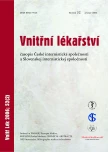The meaning of viral kinetics in the beginning of the pegylated interferon-alpha and ribavirin therapy for chronic hepatitis C
Authors:
P. Husa 1; P. Šlesinger 1; H. Štroblová 2; A. Svobodník 3
Authors‘ workplace:
Klinika infekčních chorob Lékařské fakulty MU a FN Brno, pracoviště Bohunice, přednosta doc. MUDr. Petr Husa, CSc.
1; Oddělení klinické mikrobiologie FN Brno, pracoviště Bohunice, přednostka prim. MUDr. Alena Ševčíková
2; Centrum biostatistiky a analýz MU Brno, vedoucí doc. RNDr. Ladislav Dušek, Ph. D.
3
Published in:
Vnitř Lék 2006; 52(2): 153-159
Category:
Original Contributions
Overview
Pegylated interferon α (PEG-IFN) and ribavirin combination therapy is the contemporary standard therapy of the patients chronically infected with hepatitis C virus (HCV).
Objective of the study:
The study is monitoring the changes in viremy through the changes of HCV RNA in serum before and during antiviral therapy and it attempts to find a relationship between the viral kinetics in the beginning of the therapy and the sustained virologic response.
Set of the patients and the methodics:
The study involved 133 patients with chronic infection with HCV, of the average age of 38 years (ranged 18–68 years). 86 of them were men. There were 88 patients who had not been treated before (naive patients), 19 of them were relabing and 26 were non-responders to the previous therapy with conventional IFNα and ribavirin. 106 patients (80 %) were infected with genotype (G) 1, 3 (2 %) with G2, 18 (14 %) with G3, 1 patient with G4 and 1 with G6 (under 1 %), in 4 (3 %) the genotype could not be determined. All of them were treated with the combination of PEG-IFNα-2a (180 μg once a week) and ribavirin (800 mg per day in the infection with G2 or G3, 1 000 mg at the infection with G1 and the weight up to 74 kg, 1 200 mg per day at the infection with G1 and the weight 75 kg and higher).
Results:
Up to now, 122 patients completed the therapy and 93 of them (76 %) had negative HCV RNA in serum at the time of completion of the therapy. Negative HCV RNA after 24 weeks (sustained virologic response † SVR) after the completion of the therapy had 64/107 (60 %) of the treated patients. In the course of 12 weeks of the therapy the viremy decreased by at least 2 decadic logarithms (early virologic response – EVR) in 87 patients (82 %) and in 63 of them (72 %) also SVR was noted. Only 19 patients had not EVR and just 1 one of them, nevertheless, achieved SVR (5 %).
Conclusion:
The achievement of EVR is a prerequisite to the successful therapy for chronic infection with HCV with the combination of PEG-IFNα and ribavirin. Quantitative determination of HCV RNA in serum before and during antiviral therapy is a prerequisite to the modern antiviral therapy for chronic infection with HCV.
Key words:
chronic hepatitis C – viral kinetics – pegylated interferon – ribavirin – sustained viral response
Sources
1. Němeček V. Sérologický přehled ČR v roce 2001 - virová hepatitida A, B, C. Zprávy CEM 2003; 12: 55-61.
2. Urbánek P. Infekce virem hepatitidy C. Praha: Galén 2004.
3. Husa P. Virové hepatitidy. Praha: Galén 2005.
4. Stránský J, Skřivánková J. Závažné vedlejší účinky při kombinované léčbě interferonem alfa a ribavirinem u pacientů s chronickou hepatitidou C. Vnitř Lék 2002; 47(1): 56-59.
5. Strader DFB, Wright T, Thomas DL et al. Diagnosis, management, and treatment of hepatitis C. AASLD Practice Guideline. Hepatology 2004; 39: 1147-1171.
6. Urbánek P, Husa P, Šperl J et al. Diagnostika a léčba chronické hepatitidy C. Doporučený postup České hepatologické společnosti a Společnosti infekčního lékařství ČLS JEP. Vnitř Lék 2005; 51(11): 1307-1313.
7. Neumann AU. Hepatitis C virus dynamics in vivo and the antiviral efficacy of interferon- alpha therapy. Science 1998; 228: 103-107.
8. Zeuzem S, Lee J-H, Franke A et al. Quantification of the initial decline of serum hepatitis C virus RNA and response to interferon alfa. Hepatology 1998; 27: 1149-1156.
9. Neumann AU, Lam NP, Ahari H et al. Differences in viral dynamics between genotypes 1 and 2 of hepatitis C virus. J Inf Dis 2000; 182: 28-35.
10. Zeuzem S, Herrmann E, Lee JH et al. Viral kinetics in patients with chronic hepatitis C treated with standard or peginterferon alfa-2a. Gastroenterology 2001; 120: 1438-1447.
11. Husa P, Chalupa P, Štroblová H. Výsledky sérotypizace u pacientů s chronickou infekcí virem hepatitidy C. Klin Mikrobiol Inf Lék 1998; 4: 137-140.
12. Pawlotsky JM. Treatment of hepatitis C: Different by design viral kinetics: Logic in practice. The Hepatitis C Forum. Rhodos, 19.-22.9.2002. Abstract book, 12-13.
13. Fried MW, Shiffmann ML, Reddy KR et al. Combination of peginterferon alfa-2a plus ribavirin in patients with chronic hepatitis C virus infection. N Engl J Med 2002; 347: 975-982.
14. Ferenci P, Fried M, Schiffman, ML et al. Predicting sustained virological responses in chronic hepatitis C patients treated with peginterferon alfa-2a (40 KD)/ribavirin. J Hepatol 2005; 43: 425-433.
15. Manns MP, McHutchison JG, Gordon SC et al. Peginterferon alfa-2b plus ribavirin compared with interferon alfa-2b plus ribavirin for initial treatment of chronic hepatitis C: a randomised trial. Lancet 2001; 358: 958-965.
16. Davis GL, Wong JB, McHutchison JG et al. Early virology response to treatment with peginterferon alfa-2b plus ribavirin in patients with chronic hepatitis C. Hepatology 2003; 38: 645-652.
Labels
Diabetology Endocrinology Internal medicineArticle was published in
Internal Medicine

2006 Issue 2
Most read in this issue
- Idiopathic premature ventricular complexes - catheter ablation as a therapeutic alternative
- The role of transesophageal echocardiopgraphy in detection of cardiogenic and aortic sources of embolism in stroke and transient ischaemic attacks
- Can we cure atrial flutter with radiofrequency ablation in an hour?
- Osteonecrosis of the jaw in the course of multiple myeloma treatment and bisphosphonate administration
